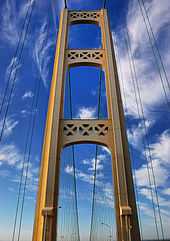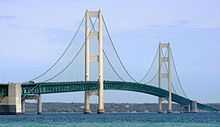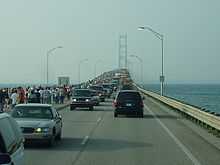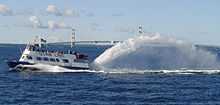Mackinac Bridge
| Mackinac Bridge | |
|---|---|
 | |
| Other name(s) | Mighty Mac or Big Mac |
| Carries |
4 lanes of |
| Crosses | Straits of Mackinac |
| Locale | Mackinaw City and St. Ignace, Michigan |
| Maintained by | Mackinac Bridge Authority |
| Design | Suspension bridge |
| Total length | 26,372 feet (8,038 m) |
| Width |
68.6 feet (20.9 m) (total width)[1] 54 feet (16 m) (road width) 38.1 feet (11.6 m) (depth)[1] |
| Height | 552 feet (168 m) |
| Longest span | 3,800 feet (1,158 m) |
| Vertical clearance | 200 feet (61 m) |
| Clearance below | 155 feet (47 m) |
| Opened | November 1, 1957 |
| Toll | $2.00 per axle for passenger vehicles ($4.00 per car). $5.00 per axle for motor homes, and commercial vehicles.[2] |
| Daily traffic | 11,600 |
| Connects: Mackinaw City and St. Ignace |
 |
| Coordinates | 45°48′58″N 84°43′37″W / 45.816°N 84.727°WCoordinates: 45°48′58″N 84°43′37″W / 45.816°N 84.727°W |
The Mackinac Bridge (/ˈmækɨnɔː/ MAK-in-aw) is a suspension bridge spanning the Straits of Mackinac to connect the Upper and Lower peninsulas of the U.S. state of Michigan. Opened in 1957, the 8,614-foot (2,626 m) bridge (familiarly known as "Big Mac" and "Mighty Mac") is the world's fifth-longest in total suspension[3] and the longest suspension bridge between anchorages in the Western hemisphere.[3] The Mackinac Bridge carries Interstate 75 and the Lakes Michigan and Huron components of the Great Lakes Circle Tours across the straits and connects the city of St. Ignace on the north end with the village of Mackinaw City on the south.
Envisioned since the 1880s, the bridge was designed by the engineer David B. Steinman and completed in 1957 only after many decades of struggles to begin construction.
Length
The bridge opened on November 1, 1957, connecting two peninsulas linked for decades by ferries. A year later, the bridge was formally dedicated as the "world's longest suspension bridge between anchorages", allowing a superlative comparison to the Golden Gate Bridge, which had a longer center span between towers, and the San Francisco–Oakland Bay Bridge, which had an anchorage in the middle.
It remains the longest suspension bridge with two towers between anchorages in the Western Hemisphere.[3] Much longer anchorage-to-anchorage spans have been built in the Eastern Hemisphere, including the Akashi Kaikyō Bridge in Japan (12,826 ft or 3,909 m). But the long leadups to the anchorages on the Mackinac make its total shoreline-to-shoreline length of 5 miles (8 km) longer than the Akashi-Kaikyo (2.4 mi or 3.9 km).
The length of the bridge's main span is 3,800 feet (1,158 m), which makes it the third-longest suspension span in the United States and 15th longest worldwide. (See also List of longest bridges in the world.)
History

The Algonquian peoples Native Americans who lived in the straits area prior to the arrival of Europeans in the 17th century called this region Michilimackinac, which is widely understood to mean the Great Turtle presumably named for the shape of Mackinac Island. This interpretation of the word is debated by scholars. The Straits of Mackinac functioned as a fur trade summer depot and inter-tribal meeting place.[4]
As exploitation of the state's mineral and timber resources increased during the 19th century, the area became an important transport hub. In 1881 the three railroads that reached the Straits, the Michigan Central, Grand Rapids & Indiana, and the Detroit, Mackinac & Marquette, jointly established the Mackinac Transportation Company to operate a railroad car ferry service across the straits.[5]
Improved highways along the eastern shores of the lower peninsula brought increased automobile traffic to the straits region starting in the 1910s. The state of Michigan initiated an automobile ferry service between St. Ignace and Mackinaw City in 1923 and eventually operated nine ferry boats that would carry as many as 9,000 vehicles per day, with traffic backups stretching as long as 16 miles (26 km).[6]
After the opening of the Brooklyn Bridge in 1883, local residents began to imagine that such a structure could span the straits. In 1884, a store owner in St. Ignace published a newspaper advertisement that included a reprint of an artist's conception of the Brooklyn Bridge with the caption "Proposed bridge across the Straits of Mackinac".[7]
At a July 1888 meeting of the board of directors of the Grand Hotel on Mackinac Island, Cornelius Vanderbilt II proposed the building of a bridge, similar to the one then under construction across the Firth of Forth in Scotland, across the straits in order to advance commerce and to help lengthen the resort season of the hotel.[7]
The idea of the bridge was discussed in the Michigan Legislature as early as the 1880s. At the time, the area was becoming a popular tourist destination, especially following the creation of Mackinac National Park on Mackinac Island in 1875.
Despite the perceived necessity for the bridge, decades elapsed with no formal plan. In 1920, the Michigan state highway commissioner advocated the construction of a floating tunnel across the straits. At the invitation of the state legislature, C. E. Fowler of New York City put forth a plan for a long series of causeways and bridges across the straits from Cheboygan, 17 miles (27 km) southeast of Mackinaw City, to St. Ignace, using Bois Blanc, Round, and Mackinac Islands as intermediate steps.
In 1923, the state legislature ordered the State Highway Department to establish ferry service across the strait. More and more people used ferries to cross the straits each year, and as they did, momentum to create a bridge grew even stronger. Chase Osborn, a former governor, wrote, "Michigan is unifying itself, and a magnificent new route through Michigan to Lake Superior and the Northwest United States is developing, via the Straits of Mackinac. It cannot continue to grow as it ought with clumsy and inadequate ferries for any portion of the year."
By 1928, the ferry service had become so popular and so expensive to operate that Michigan Governor Fred Green ordered the department to study the feasibility of building a bridge across the strait. The department deemed the idea feasible, estimating the cost at $30 million.
In 1934, the Michigan Legislature created the Mackinac Straits Bridge Authority to explore possible methods of constructing and funding the proposed bridge. The Legislature authorized the Authority to seek financing for the project. In the mid-1930s, the Authority twice attempted to obtain federal funds for the project but was unsuccessful, despite the endorsement of the United States Army Corps of Engineers and President Franklin D. Roosevelt. Nevertheless, between 1936 and 1940, a route was selected for the bridge, and borings were made for a detailed geological study of the route.
Besides the length of the span, a unique engineering challenge is the tremendous forces that operate against the base of the bridge. During winter, the lakes freeze and enormous stress is placed on the bridge structure by large icebergs.
The preliminary plans for the bridge featured a 3-lane roadway, a railroad crossing on the underdeck of the span, and a center-anchorage double-suspension bridge configuration similar to the design of the San Francisco – Oakland Bay Bridge. Because this would have required sinking an anchorage pier in the deepest area of the Straits, the practicality of this design may have been questionable.[citation needed] A concrete causeway, approximately 4,000 feet (1,219 m), extending from the northern shore, was constructed in shallow water from 1939 to 1941. At that time, with funding for the project still uncertain, further work was put on hold because of World War II. The Mackinac Straits Bridge Authority was abolished by the state legislature in 1947, but the same body created a new Mackinac Bridge Authority three years later in 1950. In June 1950, engineers were retained for the project. After a report by the engineers in January 1951,[8] the state legislature authorized the sale of $85 million in bonds for bridge construction on April 30, 1952. However, a weak bond market in 1953 forced a delay of more than a year before the bonds could be issued.
G. Mennen Williams was governor during the construction of the Mackinac Bridge. He began the tradition of the governor leading the Mackinac Bridge Walk across it every Labor Day.[9] U.S. Senator Prentiss M. Brown has been called the "father of the Mackinac Bridge,"[10] and was honored with a special memorial bridge token created by the Mackinac Bridge Authority.[11]
Engineering and construction


David B. Steinman was appointed as the design engineer in January 1953 and by the end of 1953, estimates and contracts had been negotiated. Total cost estimate at that time was $95 million with estimated completion by November 1, 1956. Tolls collected were to pay for the bridge in 20 years.[12] Construction began on May 7, 1954. The American Bridge Division of United States Steel Corporation was awarded a contract of more than $44 million to build the steel superstructure.
Construction, staged using the 1939-41 causeway, took three and a half years (four summers, no winter construction) at a total cost of $100 million and the lives of five workers. Contrary to popular belief, none of them are entombed in the Bridge.[13] It opened to traffic on schedule on November 1, 1957, and the ferry service was discontinued on the same day. The Bridge was formally dedicated on June 25, 1958. The bridge officially achieved its 100 millionth crossing exactly forty years after its dedication, on June 25, 1998.[14]
The 50th anniversary of the bridge's opening was celebrated on November 1, 2007 in a ceremony hosted by the Mackinac Bridge Authority at the viewing park adjacent to the St. Ignace causeway.[14]
History of the bridge design
The design of the Mackinac Bridge was directly influenced by the lessons from the first Tacoma Narrows Bridge, which failed in 1940 because of its instability in high winds. Three years after that disaster, Steinman had published a theoretical analysis of suspension-bridge stability problems, which recommended that future bridge designs include deep stiffening trusses to support the bridge deck and an open-grid roadway to reduce its wind resistance. Both of these features were incorporated into the Mackinac Bridge. The stiffening truss is open to reduce wind resistance. The road deck is shaped as an airfoil to provide lift in a cross wind, and the center two lanes are open grid to allow vertical (upward) air flow, which fairly precisely cancels the lift, making the roadway stable in design in winds of up to 150 miles per hour (240 km/h).
Facts and figures



The Mackinac Bridge is currently a toll bridge on Interstate 75 (I-75). Prior to the coming of I-75, the bridge carried US Highway 27 (US 27). It is one of only three segments of I-75 that are tolled, the others being the American half of the International Bridge near Sault Ste. Marie, Michigan, and Alligator Alley in Florida. The current toll is $4.00 for automobiles and $5.00 per axle for trucks.[2] The Mackinac Bridge Authority recently raised the toll to fund a $300 million renovation program, which would include completely replacing the bridge deck.[15]
Every Labor Day, two of the lanes of the bridge are closed to traffic and open to walkers for the Mackinac Bridge Walk.
Painting of the bridge takes seven years, and when painting of the bridge is complete, it begins again.[citation needed]
The bridge celebrated its 150 millionth vehicle crossing on September 6, 2009.[16]
- Length from cable bent pier to cable bent pier: 7,400 feet (2,256 m).[14]
- Total width of the roadway: 54 feet (16.5 m)[14]
- Width of stiffening truss in the suspended span: 68 feet (20.7 m).[14]
- Depth of stiffening truss: 38.1 feet (11.6 m)[1][14]
- Height of the roadway at mid-span: approximately 200 feet (61 m) above water level.[14]
- Vertical clearance at normal temperature:
- Construction cost: $99.8 million (1957 USD; adjusted for inflation, approximately $732 million, 2007 USD)[14]
- Height of towers above water: 552 feet (168 m)[14]
- Max. depth of towers below water: 210 feet (64 m)[14]
- Depth of water beneath the center of the bridge, 250 feet (76 m)[14]
- Total length of wire in main cables: 42,000 miles (68,000 km).[14]
- Total vehicle crossings, 2005: 4,236,491 (average 11,608 per day)
- Speed limit: 45 miles per hour (72 km/h) for passenger cars, 20 miles per hour (32 km/h) for heavy trucks. Heavy trucks are also required to leave 500 feet (150 m) spacing ahead.
Work and major accident fatalities
Five workers died during the construction of the bridge.[17]
- Diver Frank Pepper ascended too quickly from a depth of 140 feet (43 m) on September 16, 1954. Despite being rushed to a decompression chamber, the forty-six-year-old died from the bends.[18]
- Twenty-six-year-old James LeSarge lost his balance on October 10, 1954, and fell into a caisson. He fell 40 feet (12 m) and likely died of head injuries caused by impact with the criss-crossing steel beams inside the caisson.
- Albert Abbott died on October 25, 1954. The forty-year-old fell four feet (1.2 m) into the water while working on an 18 inch (46 cm) wide beam. Witnesses speculate he suffered a heart attack.
- Twenty-eight-year-old Jack Baker and Robert Koppen died in a catwalk collapse near the north tower on June 6, 1956. Koppen's body was never recovered. For both it was their first day on the job.
All five men are memorialized on a plaque near the bridge's southern end. Contrary to folklore, no bodies are embedded in the concrete.[19][20]
One worker has died since the bridge was completed.
- Daniel Doyle fell 60 to 70 feet (18 to 21 m) from a scaffolding on August 7, 1997. He survived the fall but fell victim to the 50 °F (10 °C) water temperature. His body was recovered the next day in 95 feet (29 m) of water.
Two vehicles have fallen off the bridge.
- On September 22, 1989, Leslie Ann Pluhar died when her 1987 Yugo plunged over the 36-inch-high (91 cm) railing. A combination of high winds and excessive speed was initially blamed.[21] Later investigation showed the driver had stopped her car over the open steel grating on the bridge's span and that a gust of wind through the grating blew her vehicle off the bridge,[22] although this is not supported by recorded wind speed measurements taken on and around the bridge at the time of the accident.[23][24]
- On March 2, 1997, a 1996 Ford Bronco went over the edge. It was later determined to be a suicide by driver Richard Alan Daraban.[25]
On September 10, 1978, a small private plane carrying United States Marine Corps Reserve officers Maj. Virgil Osborne, Capt. James Robbins, and Capt. Wayne W. Wisbrock smashed into one of the bridge's suspension cables while flying in a heavy fog. The impact tore the wings off the plane, which then plunged into the Straits of Mackinac. All three men were killed.[26]
Suicides by people jumping from the bridge have been rare, with the most recent confirmed case taking place on December 31, 2012.[27]
Crossing the bridge
The Mackinac Bridge Authority has a Drivers Assistance Program that provides drivers for those uncomfortable with driving across the Mackinac Bridge. Those interested can arrange, either by phone or with the toll collector, to have their cars or motorcycles driven to the other end. There is no additional fee for this service. Bicycles and pedestrians are not permitted on the bridge; an exception is allowed for riders of two annual bicycle tours. For a $5.00 fee, the Authority will transport bicyclists and their vehicles across the bridge.[2]
Travelers across the Mackinac Bridge can listen to an AM radio broadcast that recounts the history of the bridge and provides updates on driving conditions.[28]
Bridge Walk

The Mackinac Bridge Walk has been held each year since 1958, when it was led by Governor G. Mennen Williams. The first walk was held during the Bridge's Dedication Ceremony held in late June, and has been held on Labor Day since 1959. Thousands of people, traditionally led by the Governor of Michigan, cross the five-mile (8 km) span on foot from St. Ignace to Mackinaw City. Before 1964, people walked the Bridge from Mackinaw City to St. Ignace. The Bridge Walk is the only day of the year that hikers can hike this section of the North Country National Scenic Trail.[29]
Tourism

During summers, the Upper Peninsula and the Mackinac Bridge have become a major tourist destination.[30] In addition to visitors to Mackinac Island, the bridge has attracted interest from a diverse group of tourists including bridge enthusiasts, bird-watchers, and photographers.[31]
In media
A feature-length documentary entitled Building the Mighty Mac was produced by Hollywood filmmaker Mark Howell in 1997 and has been shown over the PBS network. The program features numerous interviews with the key people who built the structure and includes restored 16 mm color footage of the bridge's construction.[citation needed]
The bridge and its maintenance crew were featured in an episode of the Discovery Channel TV show Dirty Jobs on August 7, 2007. Host Mike Rowe and crew spent several days filming the episode in May 2007.[32][33] See List of Dirty Jobs episodes.
The history and building of the bridge was featured in an episode of the History Channel TV show Modern Marvels.[34]
On July 19, 2007, the Detroit Science Center unveiled an 80-foot-long, 19-foot-tall scale model of the Mackinac Bridge. The exhibit was part of the state’s 50th anniversary celebration of the bridge that opened to traffic Nov 1, 1957. Sherwin-Williams supplied authentic Mackinac Bridge-colored paint for the project.[35]

In print
On June 25, 1958, to coincide with the 1958 celebration of the November 1957 opening, the US Postal Service (USPS) released a 3¢ Commemorative stamp featuring the recently completed bridge. It was entitled "Connecting the Peninsulas of Michigan" and 107,195,200 copies were issued.[36] The U.S. Postal Service again honored the Mackinac Bridge as the subject of its 2010 Priority mail $4.90 stamp, which went on sale February 3.[37] The Bridge Authority and MDOT unveiled the stamp, which featured a "seagull’s-eye view" of the landmark, with a passing freighter below.[38] Artist Dan Cosgrove worked from panoramic photographs to create the artwork. This is one of several designs that Cosgrove has produced for the Postal Service.[39]
MDOT also featured the bridge on the cover of the 2007 state highway map.[40]
See also
References
- ↑ 1.0 1.1 1.2 Mackinac Straits Bridge at Structurae. Retrieved on January 30, 2010.
- ↑ 2.0 2.1 2.2 Staff (2010). "Mackinac Bridge Fare Schedule". Mackinac Bridge Authority. Retrieved January 30, 2010.
- ↑ 3.0 3.1 3.2 Staff (2010). "About the Bridge". Mackinac Bridge Authority. Retrieved January 30, 2010.
- ↑ "Mackinaw, Mackinac Straits, Mackinac Island". Michilimackinac. Retrieved November 2, 2013.
- ↑ Staff. "I-75 / Straits of Mackinac". Michigan's Historic Bridges. Michigan Department of Transportation. Retrieved November 2, 2013.
- ↑ Staff. "Mackinac Bridge". American Society of Civil Engineers. Retrieved December 5, 2013.
- ↑ 7.0 7.1 "History". Michigan Department of Transportation. Retrieved November 2, 2013.
- ↑ Ammann, Othmar (January 10, 1951) (PDF). Proposed Mackinac Straits Bridge Preliminary Report (Report). http://www.michigan.gov/documents/deq/Proposed_Prelim_Report_opt_306071_7.pdf. Retrieved April 15, 2013.
- ↑ Staff (2004). "Michigan Governor Gerhard Mennen Williams". National Governors Association. Retrieved January 30, 2010.
- ↑ Staff (2010). "Prentiss M. Brown, Father of the Mackinac Bridge". Mackinac Bridge Authority. Retrieved January 30, 2010.
- ↑ Staff (2010). "Mackinac Bridge commemorative token gift packs". Mackinac Bridge Authority. Retrieved January 30, 2010.
- ↑ "Mackinac Bridge Will Rival Golden Gate". Popular Mechanics 100 (2): 132. August 1953. ISSN 0032-4558. Retrieved February 21, 2012.
- ↑ Staff. "In Memory of: Bridge Workers". Mackinac Bridge Authority. Retrieved February 21, 2012.
- ↑ 14.0 14.1 14.2 14.3 14.4 14.5 14.6 14.7 14.8 14.9 14.10 14.11 14.12 14.13 14.14 14.15 Staff. "Facts and figures". Mackinac Bridge Authority.
- ↑ "Mackinac Bridge Authority Proposes Raising Tolls to Pay for Renovations". Walker, MI: WZZM-TV. November 7, 2007. Retrieved January 5, 2013.
- ↑ Staff (September 7, 2009). "150 Millionth Vehicle Crosses Mackinac Bridge" (Press release). Mackinac Bridge Authority. Retrieved March 19, 2010.
- ↑ Staff (2010). "In Memory of". Mackinac Bridge Authority. Retrieved January 30, 2010.
- ↑ "Bridge Workers". Mackinac Bridge Authority. Retrieved June 18, 2013.
- ↑ Michigan History. July–August 2007.
- ↑ Staff (2008). "Frequently Asked Questions". Mackinac Bridge Authority. Retrieved September 23, 2011.
- ↑ Zacharias, Pat (June 6, 2000). "The Breathtaking Mackinac Bridge". The Detroit News. Retrieved September 11, 2010.
- ↑ Propson, David (October 14, 2004). "How to Build a Better Bridge". New York Sun. Retrieved October 26, 2007.
- ↑ McGraw, Bill (July 8, 2007). "Mackinac Bridge Q&A". Detroit Free Press. Retrieved January 3, 2014.
- ↑ "Accident Report Claims Ms. Pluhar Was Speeding". The Argus-Press (Owosso, MI). Associated Press. November 8, 1989. p. 20. Retrieved January 3, 2014.
- ↑ Daraban v. State of Michigan, et al., 223659 (State of Michigan Court of Appeals March 15, 2002).
- ↑ "Reserve Officers Died In Mackinac Bridge Crash". Argus-Press (Owosso, MI). Associated Press. September 12, 1978. Retrieved January 5, 2013.
- ↑ Britton, Zac (January 2, 2013). "Investigation remains open following Mackinac Bridge jump". Petoskey News-Review.
- ↑ Staff. "WNHC787 AM 530 St. Ignace / AM 1610 Mackinaw City". Michiguide.com. Retrieved September 20, 2008.
- ↑ Staff. "Michigan". North Country Trail Association. Retrieved July 11, 2012.
- ↑ "Mackinac Bridge Crossings". Michigan Tourism Business (Michigan State University) 3 (1). February 24, 2004. Retrieved January 30, 2010.
- ↑ Staff (2010). "Photo Gallery". Mackinac Bridge Authority. Retrieved January 30, 2010.
- ↑ "Crew from "Dirty Jobs" in Northern Michigan". Cadillac, MI: WWTV-TV. May 23, 2007. Retrieved January 30, 2010.
- ↑ "Dirty Jobs, Season 3, Episode 5". Internet Movie Database. 2010. Retrieved January 30, 2010.
- ↑ ""Modern Marvels" Mackinac Bridge (2003)". Internet Movie Database. 2010. Retrieved January 30, 2010.
- ↑ "Detroit Science Center To Open 'Mini Mac' Exhibit" (Press release). Detroit Science Center. June 19, 2007. Retrieved January 30, 2010.
- ↑ Stokes, Keith. "New Mackinac Bridge Postage Stamp". The Mighty Mac.
- ↑ "USPS announcement, 2010 Mackinac Bridge commemorative" (Press release). US Postal Service.
- ↑ "Mighty Mac Stamp to be Unveiled". Detroit Free Press. January 29, 2010. Retrieved January 30, 2010.
- ↑ "2010 Stamp Designs" (Press release). U.S.Postal Service. Archived from the original on April 19, 2010. Retrieved September 9, 2010.
- ↑ Michigan Department of Transportation (2007). Official Department of Transportation Map (Map). 1 in.:15 mi/1 cm:9 km. Cartography by MDOT. Front Cover.
Further reading
- Brown, Prentiss M. (1956). The Mackinac Bridge Story. Detroit: Wayne State University Press. OCLC 5392305.
- "Mackinac Bridge". Civil Engineering. May 1956.
- "The Mighty Mac at 50". Michigan History (Special ed.) 9 (4). July–August 2007.
- Ratigan, William (1959). The Long Crossing. Grand Rapids, MI: Eerdmans. OCLC 1686567.
- —— (1957). Straits of Mackinac! Crossroads of the Great Lakes. Grand Rapids, MI: Eerdmans. OCLC 3478409.
- Rubin, Lawrence A. (1985). Bridging the Straits. Detroit: Wayne State University Press. ISBN 0-8143-1789-8.
- —— (1986). Mighty Mac: The Official Picture History of the Mackinac Bridge. Detroit: Wayne State University Press. ISBN 978-0-8143-1098-4.
- Steinman, David B.; Nevill, John T . (1957). Miracle Bridge at Mackinac. Grand Rapids, MI: Eerdmans. OCLC 1227671.
- Zacharias, Pat (June 6, 2000). "The Breathtaking Mackinac Bridge". The Detroit News.
External links
| Wikimedia Commons has media related to Mackinac Bridge. |
- Mackinac Bridge Authority
- Length Comparison
- Mackinac Bridge photographs and facts
- Monitoring the Mighty Mac, Point of Beginning, 2007
- Web cams monitoring the Mackinac Bridge
- Historic American Engineering Record (HAER) No. MI-329, "Mackinac Straights Suspension Bridge"
| ||||||||||||||||||||||